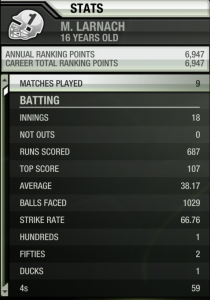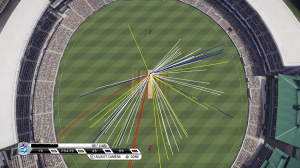
A gradual but inevitable descent into cricket-based loathing and bile.
In The Air! And Safe! And Out! 51allout’s Guide To Don Bradman Cricket ’14
Back when we were young, irresponsible and generally ignorant of the ways of the world (i.e. up till the time when we had to start paying our own bills), our dream job was to work on a video game hotline. You know the sort, the type you would ring late on Christmas day when you couldn’t get past the second level of the game you had received just that morning. The sorts of people you would speak to on the other end were not just gamers, they were gaming professors. Familiar with all the arcane mysteries of the sorts of badly coded rubbish that publishers saw fit to flood the market with in those days (a tradition EA Sports continues to this very day). The release of the best bloody cricket game in ages has afforded us, for one brief moment, to try and live out those dreams. This, therefore, is our guide to Don Bradman Cricket ’14.
When we reviewed DBC’14 a few weeks ago, we said it was pretty close to perfection, and just in need of patching out a few quirks. In that time patches have duly arrived (on the PC version at least, the console patch is still in the works) which addressed all of our misgivings. The game is now as good as you could want it to be (baring the mountain loads of statistics we would love to see incorporated). We can’t say much about the bowling side of things (and won’t, since we frankly find it kinda boring) but batting is now punishing but fair. As long as you can concentrate for long enough, there’s nothing stopping you from raking up some pretty impressive totals. And it all feels very satisfying too.

To be honest, we’re pretty proud of that strike rate. That’s some proper batting that is.
Our (in no way authoritative or definitive) guide is aimed at playing the game in career mode, where you start as a 16 year old on either the Australian or English domestic circuit and try and rise up through the ranks into the international squads. This is by far the most rewarding part of the game, and where you will spend most of your time.
The first issue is setting up your player. You can give yourself any batting position you like, but that’s the position you will have for the rest of the career, and where you will bat in international teams too, shoving out whoever was there before. So if you really want to see Alastair Cook booted from all English squads, by all means make yourself an English number one. The second point is the difficulty level. There’s a big jump between Amateur and Pro. In the former you don’t have to bother with footwork, just the timing of your shot. In the later footwork is important. Also quick bowlers bowl about 15km/h slower on Amateur, which gives you much more time to play your shots.
We would actually advise starting your career on Amateur. Reason being, you will be absolutely shit at game start, with no in-game skills at all. This will make the first year or so a pretty tough slog. By the time you have played for a bit, built up some skills and are on the verge of international selection, you should be finding domestic cricket much easier. But when you play international games, the difficulty goes up a notch, to Pro, which makes things much tougher again. Which, in our opinion, is the way it should be.

Our current selection status leads us to believe English T20 teams will sign pretty much anyone.
You will still find batting pretty demanding when starting out though. Remember that the block button is your friend. Before the recent patches blocking was a bit of a liability, but now it’s pretty safe. You can still get out blocking but this happens very rarely. So if in doubt, block. Typically full length balls from both spinners and quicks should be blocked, at least until your batsman has his confidence up. Confidence isn’t shown on screen, but you can check it by pressing right on the d-pad when you are on strike before an over begins.
Till your confidence is up it’s best to play as straight as possible. There isn’t much danger in punching the ball down the ground (the bowler will rarely, if ever, hold on to caught and bowled chances). It’s when you try playing at wide balls, or across the line, you seem to get into trouble. Pulling short deliveries is also productive, but for some reason cut shots seem to be fraught with risk, bad news if you’re planning on emulating Tim Ambrose. Using power shots to loft balls straight when the field is up is also recommended, especially since the AI tends to set some pretty ridiculous fields at times. Just don’t get carried away, especially against the spinners (who can be tricksy bastards and tend to vary their flight and speed a lot). It’s usually not advisable to try and take on fielders on the rope though. Not unless you are trying to emulate KP for some reason.

Our first domestic ton. Cut shots are the plaything of the devil, so we avoided them entirely.
When starting out though, it’s probably better to just try and survive as long as possible. Every six balls you face gives you a bonus +1 to a batting skill. This goes for net sessions in-between games too, where you will face 60 balls, so if you manage to hit all 60, that’s another 10 skill points (it helps to set the bowling machine to bowl in one specific area, or otherwise it will spray a fair few down legside where you can’t reach them). Boundaries give you another +1, while sixes give you +2. But batting all day, blocking as many as possible, will see you quickly level up. Leaving balls is, therefore, pretty redundant. It’s also pretty risky, as the AI typically bowls a middle, middle and off line. Besides, there is seldom much pressure to score runs as your AI partners are usually happy to throw the bat whatever the match situation.
Batting for long periods is beneficial too, since bowlers will tire over the course of a day. A fast bowler who begins bowling round 145-150 km/h, will slow appreciably as the day goes on, making scoring much easier. It just takes a bit of patience to see off their early spells before you can begin to cash in though. Which isn’t one of our strong points admittedly.

Our skill level, midway through the first season. That 1 in the helmet top left means we are still pretty shit (you are ranked between 1 and 5). Also, for a 16 year old, that is one of the great beards.
The one scenario where batting becomes really difficult is limited over games when the field has been pushed back. Till you level up, boundaries will be rare without the use of power shots, meaning you will be mostly taking singles, with the occasional two, in an Alastair Cook style. It becomes challenging to maintaining discipline when the scoring rate dips, but there’s not really much you can do about it. Not in your first season or so at least. The best thing to do, in our experience, is try and make some cheap runs when the field is up early, before settling in later and letting you AI partner take most of the risks. A bit boring, but effective nonetheless.
That’s about all there is to it really. Try and be patient, wait for the bad ball and do your best to not run yourself out in the meantime. We are sure there are other (probably better) tactics out there (if anybody wants to share them….), but honestly, in our 100+ hours or so with the game thus far (yes, we have no lives) this seems to be the approach that works for us. Well, it does most of the time anyway. Kinda.

3 Comments
Post a Comment
1
Shaun
15 Oct 2014 09:39
i find it a little insulting to name this game ‘Don Bradman Cricket’.
2
Nichael Bluth
11 Sep 2014 01:11
:ninja:
3
Matt H
10 Sep 2014 12:32
Are Alistair and Alastair Cook brothers?